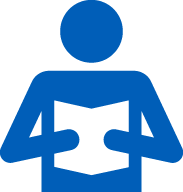Attracting and recruiting people with disability to your organisation

1. Overview
This guide provides information on how to attract people with disability to your organisation by:
- demonstrating a commitment to accessibility and inclusion as organisational values
- outlining ways to proactively connect with candidates with disability
- establishing accessible and inclusive recruitment practices.
People with disability have a wide range of experiences, skills, abilities and qualifications to bring to the workplace, work in a wide range of jobs across all levels, including entry level, middle management and senior leadership roles.[1]
Australian and international studies have found that people with disability are reliable and productive employees, have fewer workplace accidents than employees without a disability and take fewer sick days.[2]
2. Demonstrating a commitment to accessibility and inclusion
Many employers realise the importance and benefits of having a strategic approach to diversity and inclusion within the workplace. However, some organisations still struggle to create a workplace that is inclusive or welcoming of people with disability.
Sometimes employers assume being accessible and inclusive only means providing physical access like ramps, accessible bathrooms and automatic opening doors. However, there are many other important ways to demonstrate that you welcome and want to attract a diverse workforce including people with disability.
An employer can demonstrate its commitment to accessibility and inclusion in the workplace by:
- using inclusive and respectful language[3]
- using images of people with disability on its website, in particular, on careers or recruitment pages
- including a reference to attracting people with disability to the organisation in their diversity statement or plan
- featuring stories of existing employees with disability that work at the organisation in internal and external communications
- asking senior leaders to act as disability champions and publicly promote the benefits of employing people with disability
- developing a Disability Action Plan and promoting commitment to becoming a more inclusive employer[4]
- ensuring all staff events are accessible and inclusive
- providing disability awareness and confidence training to all employees, with a focus on training managers and people leaders
- establishing a Disability Employee Network (DEN) led by people with disability and promoting their activities and achievements on the organisation’s website
- developing a campaign about the organisation’s commitment to accessibility and inclusion, that specifically incorporates disability.
For more information on ways to demonstrate a commitment to accessibility and inclusion, and to understand what candidates are looking for, see the IncludeAbility guides on Creating an accessible and inclusive workplace, Establishing a Disability Employee Network and Identifying accessible and inclusive employers.
Case Study
Barclays “This is Me” campaign
The “This is Me” campaign challenges the stigma around mental health at work and aims to break the culture of silence by supporting people to tell their own stories.
The campaign was created to encourage understanding about mental health issues and develop an environment where employees could comfortably speak out about their own personal experiences of mental health and wellbeing.
Sharing stories both on film, and online, is a pillar of the campaign. This enabled employees to be authentic in telling their story and to capture the whole person, not just a challenge or problem.
“I’m a son and a brother. I work in finance and am studying for chartered accountancy. I have suffered from depression. I represented Barclays at ‘One Young World’ in South Africa. I’m cycling across Vietnam for charity.”
Uzair Patel.[5]
Growing the campaign
It began with only nine colleagues, who were part of the Reach network, talking about their own personal mental health challenges and has grown to include nearly 200 stories and over 60,000 visits to the web page. There has been an overwhelmingly positive response to the campaign, with improvement in trust and engagement attitudes. Disability disclosure rates have increased and Barclays is retaining talent as more employees successfully return to work after mental health-related leave of absence. The campaign has helped build the confidence of those who have shared their stories.
“I felt a responsibility to let colleagues know that they are not alone and that they are allowed to feel depressed, anxious, stressed etc. It isn’t weak to do so but instead shows strength and maturity.”
Uzair Patel.[6]
Broader application
The Barclays “This is me” campaign provides an example of how employment campaigns can grow and dramatically increase positive awareness of disability inclusion at work. While this campaign chose to focus specifically on the area of mental health, the same principles can be used across the broad spectrum of disability.
3. Proactively connect with candidates with disability
Once you have considered how to best demonstrate your organisation’s commitment to accessibility and inclusion, it is helpful to focus on how to proactively seek out candidates with disability to come and work for your organisation.
An employer can connect with candidates with disability by:
- engaging with a Disability Employment Services (DES) provider (see the following column for further information DES providers)
- advertising on a job search site dedicated to people with disability (for example, Toozly (see page 5 for further information on Toozly)
- engaging with disability organisations that support people with disability (for example, peak disability organisations or disability advocacy organisations that may be located in your community)
- identifying a number of graduate and internship positions as targeted positions for candidates with disability.
Disability Employment Services
Through Disability Employment Services, people with disability, an injury or a health condition may be able to receive assistance to prepare for, find and keep a job.
Providers of Disability Employment Services, or ‘DES providers’, are a mix of large, medium and small, for-profit and not-for-profit organisations that are experienced in supporting people with disability as well as providing assistance to employers to put in place practices to support the employee in the workplace.
DES are comprised of two parts:[7]
- Disability Management Service is for job seekers with disability, injury or health conditions who need assistance to find a job and occasional support in the workplace to keep a job.
- Employment Support Service provides assistance to job seekers with permanent disability to find a job and who need regular, ongoing support in the workplace to keep a job.
Toozly: advertise on a dedicated site for people with disability
“Toozly is Australia’s largest job search website for people with disabilities.
Toozly was created by professionals with over 30 years experience in Disability Employment Services, Business, Human Resources, Psychology, Education and Training.
We don’t just talk the talk. 100% of Toozly staff are either people with disabilities or carers of a person with a disability.”[8]
For more information see: www.toozly.com.au
4. Establishing accessible and inclusive recruitment practices
A key part of attracting people with disability to an organisation is establishing accessible and inclusive recruitment practices.
4.1 Job advertisements and position descriptions
When developing job advertisements and position descriptions, the accessibility and inclusiveness of a potential employer can be demonstrated by:
- including a diversity statement that encourages applications from people with diverse backgrounds, including people with disability
- ensuring all job advertisements encourage applicants to request reasonable adjustments if required to assist them through the application and recruitment process (for example, ‘applicants can request a reasonable adjustment at any stage during the recruitment process by getting in touch with the contact person’)
- not including any non-essential requirements in the position description (for example, a requirement for a drivers licence if this relates to sporadic travel that could be facilitated by public transport or a taxi, rather than a core part of the role)
- indicating a willingness to customise the role for the right candidate (see below for further information on job customisation)
- including the details of a contact person so that applicants can get in touch by phone or email.
Job customisation
Job customisation is a process of individualising or tailoring a certain role to suit the skills of an employee, while meeting the needs of the employer.
It typically involves a process of negotiation before the prospective employee begins their role and can include the reallocation of tasks, or exchanging duties with another colleague. The aim of these negotiations is to arrive at a mutually beneficial employment relationship where an employee’s experience and capabilities are matched to an appropriate job.
For more information on job customisation see the IncludeAbility guide on Customising a job for a person with disability.
4.2 Interviews and assessment processes
When arranging interviews and assessments, the accessibility and inclusiveness of a potential employer can be demonstrated by:
- asking all candidates progressing to the interview or assessment stage if they require any reasonable adjustments, and facilitating these
- confirming that the physical location for the interview or assessment is accessible, both externally and internally
- confining any assessments (including medical assessments) to the essential requirements of the job[9]
- ensuring that candidates are able to access any online platforms being used for the interview or assessment process and, if not, providing an alternative format.
Ambassador reflection
“At the beginning of 2019 I was employed at Women With Disabilities Australia through a standard application and interview process. I found this process extremely difficult; but felt very grateful that my employer was able to look past my social difficulties.
I think there are a lot of things organisations can do to improve the employment rates and experiences of people with disability. But one of my top recommendations would be to consider alternative ways to recruit staff. Traditional interview processes rarely reflect how a person works.”
Heidi La Paglia
Project & Policy Officer
Women With Disabilities Australia
IncludeAbility Ambassador
Tip
Group interviews or Assessment Centres may not be suitable for some people with disability to demonstrate their skills and suitability for a role.
For example, a person with anxiety may feel overwhelmed in a group interview, but perform well in a one-on-one setting.
Reasonable adjustments during the recruitment process
Reasonable adjustments – sometimes called workplace adjustments or reasonable accommodations – are changes to work processes, practices or environments, that are made to ensure an employee with disability can perform their job, free from barriers.
In the context of the recruitment process this may include:
- additional time for the interview or any tasks associated with the recruitment
- an alternative approach to completing any online assessment tasks if the online system is not accessible
- the provision of accessibility supports, such as live captioning, an Auslan interpreter or a support person.
If a candidate does decide to share information about their disability with a potential employer in the interview, it is helpful to be aware of what is, and is not, appropriate to ask the candidate.
It is unlawful for an employer to ask a candidate anything relating to personal attributes like sex, age or disability, if those questions are unrelated to the position they are applying for.[10]
The following guidance on questions has been adapted from the JobAccess, Interviewing People with Disability, guide.[11]
-
Employers can
- Ask questions about how the candidate’s disability relates to doing the job and working safely
- Ask how the workplace could be changed or improved to help the candidate do the job
- Ask about how work hours or rosters could be changed to help the candidate perform better in the role
- Ask questions about keeping the workplace safe for the candidate and everyone else
- Ask the candidate whether they take any medications which might make it unsafe to perform any tasks involved in the role
- Ask if there is any information or awareness training the candidate would like provided to their colleagues about their disability
-
Employers cannot
- Ask personal questions about the candidate’s lifestyle or how they manage their disability
- Ask the candidate general questions about their health or disability
- Ask the candidate how many times per year they go to the doctor or what the doctor says to them in those appointments
- Treat the candidate differently or less favourably because they have a disability
- Ask the candidate whether they take lots of medication for their disability or illness
- Tell others about the candidate’s disability without asking the candidate first
Tip
Once the recruitment process has concluded and a successful candidate has been identified, it is good practice for an employer to ask their new employee again if they require any adjustments to perform their role.
This will provide another opportunity for the employee to identify as a person with disability if they chose not to do so during the recruitment process. It also demonstrates a genuine commitment to an accessible and inclusive workplace.
For information on how to facilitate an accessible and inclusive induction process see the IncludeAbility guide on Creating an accessible and inclusive induction.
Endnotes
[1] AIHW, ‘People with Disability in Australia’ Australian Government, Australian Institute of Health and Welfare, AIHW (Web Report, 2 October 2020).
[2] Australian Chamber of Commerce, Employ Outside the Box: The Business Case for Employing People with Disability (Report, November 2014) 7.
[3] People with Disability Australia, Language Guide (Web Page).
[4] Australian Human Rights Commission, Action plans and action plan guides (Web Page, 14 December 2012).
[5] Barclays, This is me (Web Page).
[6] Barclays, This is me (Web Page).
[7] Australian Government Department of Social Services, Disability Employment Services (Web Page, 22 August 2019).
[8]Toozly, About Us (Web Page).
[9] Disability Discrimination Act 1992 (Cth) s 15(1), 21A.
[10] For example, see Disability Discrimination Act 1992 (Cth) s 30; Fair Work Act 2009 (Cth) s 351.
[11] Australian Government Job Access, Interview people with disability (2020).
|
This guide is part of a suite of resources developed by the Australian Human Rights Commission as part of IncludeAbility to assist:
Explore our other Disability Employment resources. |



